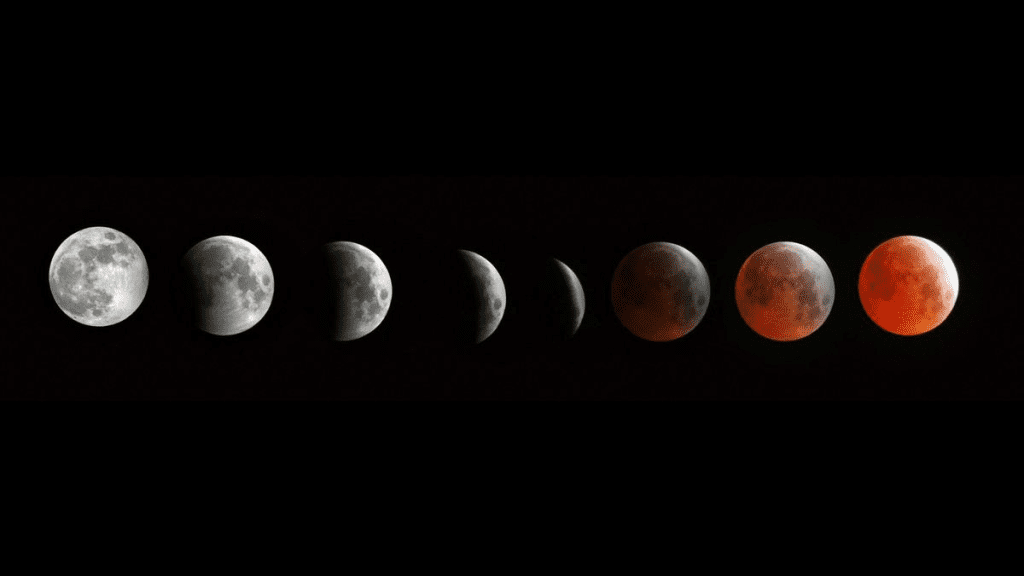Skywatchers, get ready! On the night of March 14-15, 2025, a total lunar eclipse will grace the skies, offering a breathtaking celestial spectacle. For approximately 65 minutes, the Moon will transition from its usual bright white glow to a dramatic deep red or brown hue, creating a mesmerizing sight known as the Blood Moon.
If you’re fascinated by astronomy or simply love witnessing nature’s wonders, this is an event you won’t want to miss. Whether you’re planning to observe it with the naked eye, through a telescope, or capture stunning photographs, this guide will provide all the essential details you need.
What Is a Total Lunar Eclipse?

A total lunar eclipse occurs when the Earth comes directly between the Sun and the Moon, casting a shadow that completely covers the Moon. Unlike a solar eclipse, which requires protective eyewear, a lunar eclipse is perfectly safe to view with the naked eye.
During this event, the Earth’s atmosphere filters sunlight, allowing only longer-wavelength red and orange light to reach the Moon. This is what gives the Moon its eerie red or brown appearance, often referred to as a Blood Moon.
When and Where Can You See It?
The total lunar eclipse will be visible from various parts of the world, but some regions will experience a better view than others. Here’s what you need to know:
- Best viewing locations: North America, South America, parts of Europe, and western Africa will get the best views of the full eclipse.
- Partial visibility: Some areas in Asia and eastern Africa will see only a partial eclipse.
- Total eclipse duration: Approximately 65 minutes of complete totality.
- Eclipse phases: The entire event, from the penumbral phase to the total eclipse and back, will last about three hours.
Video : Total Lunar Eclipse 2025: Will the Stunning Blood Moon Grace Your Skies?
If you’re in an area where visibility is limited due to weather conditions or location, don’t worry! Many astronomy organizations and space agencies will offer live-streams of the event.
What Causes the Blood Moon Effect?
One of the most fascinating aspects of a total lunar eclipse is the Blood Moon phenomenon. But why does the Moon turn red instead of disappearing completely?
This happens due to a process called Rayleigh scattering, the same mechanism responsible for red sunsets and sunrises. When the Earth blocks direct sunlight from reaching the Moon, some of the Sun’s light bends through the Earth’s atmosphere. The shorter wavelengths (blue and violet) scatter, while the longer red and orange wavelengths pass through and illuminate the Moon.
Depending on atmospheric conditions, the Moon can appear in shades ranging from deep red to copper or brown. If there are dust or volcanic particles in the atmosphere, the eclipse could take on an even darker hue.
How to Watch the Total Lunar Eclipse
Viewing a total lunar eclipse is easy and requires no special equipment. However, for the best experience, consider these tips:
- Find a dark location: The farther you are from city lights, the clearer your view will be.
- Check the weather: Cloudy skies can block your view, so make sure to check local forecasts.
- Use binoculars or a telescope: While the eclipse is visible to the naked eye, magnification enhances details like craters and surface textures.
- Capture the moment: If you love photography, use a DSLR camera with a tripod to get sharp images of the Moon’s color changes.
- Bring friends and family: Viewing an eclipse is a magical experience—share it with others!

Why This Lunar Eclipse Is Special
Not all lunar eclipses are created equal. Some are penumbral (where the Moon only passes through Earth’s outer shadow), while others are partial (where only part of the Moon is covered).
However, this event on March 14-15, 2025, is a total lunar eclipse, meaning the Moon will be completely engulfed by Earth’s shadow, creating an intense and dramatic visual effect.
Additionally, this eclipse comes at a time when interest in space and astronomy is at an all-time high, with upcoming missions to the Moon and Mars capturing global attention.
The Cultural and Historical Significance of Lunar Eclipses
Throughout history, lunar eclipses have been seen as mystical and sometimes ominous events. In ancient civilizations:
- The Incas believed a lunar eclipse occurred when a jaguar attacked the Moon.
- The Chinese thought a giant celestial dragon was devouring the Moon and would make loud noises to scare it away.
- Many Native American tribes viewed the event as a sign of change or transformation.
Today, lunar eclipses are understood scientifically, but they still inspire a sense of wonder and curiosity.
Video : Total Lunar Eclipse Blood Moon 14 March 2025 Your Horoscope with Gregory Scott
The Next Total Lunar Eclipses After March 2025
If you miss this one, don’t worry—there are more lunar eclipses coming in the future. The next total lunar eclipses will occur on:
- March 3, 2026
- December 31, 2028
- December 20, 2029
However, the March 2025 eclipse will be one of the longest and most visible in recent years, making it a must-watch event.
Final Thoughts: Don’t Miss This Celestial Event!
The March 14-15, 2025, total lunar eclipse is a rare and breathtaking natural event that reminds us of the beauty of our universe. Whether you’re an astronomy enthusiast or just someone who enjoys witnessing celestial wonders, this is an opportunity you won’t want to miss.
Mark your calendars, find a good viewing spot, and prepare to watch the Moon turn a stunning shade of red as it aligns perfectly with the Earth and Sun.
Are you excited for the eclipse? Share your thoughts in the comments and let us know where you’ll be watching from! Also, don’t forget to share this article with fellow space lovers so they can witness this incredible event, too.
I Got Engaged to a ‘Perfect’ Woman – When I Met Her Parents for the First Time, I Canceled the Wedding

When I met the woman of my dreams, I believed we were perfect for each other! But after I met her parents, I had major doubts about our future together. It took a while, but I finally saw her for who she was, and I didn’t like it!
As a 31-year-old man, I’d dated a couple of different women in my life, but when I saw Olivia, my life changed. I knew I wanted her to be my wife after our first meeting but learned the hard way that taking time to know someone is ideal. Here’s my story.

A man at a music concert | Source: Midjourney
I met the beautiful and lively Olivia at a concert. When I first spotted her, she was standing near the stage, singing along to every word of our favorite band’s songs—her energy electrifying! I was there alone, trying to soak in the music after a rough week at work, and her joy was contagious!
During the intermission, I managed to maneuver closer to her and struck up a conversation. We clicked instantly, bonding over our shared love for indie rock and terrible karaoke. By the end of the night, I had her number and a gut feeling that I’d just met someone extraordinary!

A man bonding with a woman | Source: Midjourney
Our relationship took off faster than I expected. Olivia was everything I’d ever wanted in a woman! She was charming, passionate, and endlessly supportive! Her vibrant personality was addictive, making every day feel like an adventure.
After only four months of dating bliss, we decided to move in together. It felt right, everything about us felt right! My apartment was small and bland, while Olivia’s place was larger and full of life, like her.

A large apartment | Source: Midjourney
She had plants on every windowsill, cozy blankets, and shelves of well-loved books. Blending our lives was effortless. What I didn’t anticipate was that living together would only deepen my affection for her.
We were the perfect couple in my eyes, and some of my friends who met her thought the same. We cooked dinner together, binge-watched old sitcoms, and hosted game nights with her friends and mine.

A couple hanging out with friends | Source: Midjourney
Olivia had this way of making the mundane feel special, and my friends loved her! After eight months, I knew she was the one! So, I planned another trip to a concert by the same band that was playing when we first met.
I was nervous when I bought the engagement ring, but we’d spoken about our future, and she’d excitedly revealed that she’d love to marry me and have children. That was all I needed to know. I hid the ring in my jacket and pulled it out at the perfect moment.

A man looking at a wedding ring | Source: Midjourney
I proposed at the concert, the same band playing a love song we adored in the background, and she said yes without hesitation! I thought I was the luckiest man alive! But I should’ve known better than to rush into things so quickly.
Because things moved so fast between us, we hadn’t met each other’s families yet. But Olivia always spoke highly of her parents, describing them as “fun and old-school.” She mentioned they were excited about the engagement and wanted to meet me.

A couple talking | Source: Midjourney
They planned a trip to visit us, and Olivia suggested celebrating our engagement with them at an upscale restaurant. I was nervous but eager to make a great impression.
The plan was that Olivia would meet my parents soon afterward. I spent the day preparing for the big day by getting my best suit pressed. I even rehearsed polite conversation and Googled ways to connect with potential in-laws.

A man using his laptop | Source: Midjourney
When we finally arrived at the restaurant, my nerves started kicking in, but I brushed them off, knowing I’d come prepared. As we entered, Olivia helped ease my tension by squeezing my hand and whispering, “Relax, they’re going to love you just like I do.”
But from the moment her parents arrived, I knew this dinner wouldn’t be normal. As soon as we sat down and I was introduced to her parents, they made me regret ever coming.

A couple sitting at a table | Source: Midjourney
Her father, Richard, was a broad-shouldered man with a commanding presence and a serious air about him. He barely acknowledged me as he took his seat. Her mother, Diane, adorned in enough jewelry to blind the waiter, gave me a quick once-over before turning to Olivia with a tight-lipped smile.
“So, Tommy, right?” Richard began. Without giving me a chance to respond, he said, “Let’s talk about your future roles now that you’re marrying our daughter.”

A serious older man talking | Source: Midjourney
I smiled, thinking he was referring to becoming part of the family or shared traditions. Instead, he leaned back and said, “Olivia’s been dreaming of quitting her job to be a full-time homemaker. You’ll need to cover all the household expenses so she can focus on that.”
I blinked, unsure if I’d heard him correctly.
Diane chuckled, swirling her wine. “Oh, and don’t forget a little financial help for us wouldn’t hurt. Just a small monthly amount for your new in-laws—it’s the least a loving son-in-law can do, right?”

A happy woman talking | Source: Midjourney
I froze in place, my smile faltering before I managed to squeak, “I’m sorry—what?”
Richard’s face remained stone-cold as he nodded as if the conversation was normal. “You want to marry into the family, right? So, you have to provide. Your wife shouldn’t have to work. And we’ll appreciate a modest amount for our pension from you as well.”
I glanced at Olivia, expecting her to laugh it off! But she only smiled sweetly and said, “It’s not a big deal, baby. Really. It’s how we’ve always done things in our family.”

A happy woman | Source: Midjourney
The waiter conveniently appeared with our drinks, giving me a moment to process this insanity! I felt like I’d been sucker-punched and was struggling to catch my breath. But looking back, there were small things I ignored.
Olivia tended to brush off any serious conversations I wanted to have. Once, when we talked about finances, she laughed and said, “Oh, my parents have always told me I’d marry someone who’d take care of me.” I thought it was a joke, until now.

A couple talking | Source: Midjourney
While everyone placed their food orders, I sat there in awe, mulling over what I’d just heard. When the waiter turned to me, I ordered the first thing I saw on the menu, completely dazed and consumed by what Olivia and her parents had told me.
After the waiter left, Richard continued as if he were negotiating a business merger. “It’s not just about you providing money, of course. My daughter deserves the lifestyle she’s grown accustomed to—vacations, fine dining, spa days, and such. You’ll need to buy her apartment from us too. We raised her with high standards, after all.”

A serious man talking | Source: Midjourney
Diane leaned in. “And eventually, you’ll need a bigger place. This apartment is fine for now, but our grandchildren will need more space. And when we visit, we expect to have a bedroom dedicated to us.”
My appetite completely vanished as the food was served. Every word out of their mouths felt surreal, and so did the whole evening! I glanced at Olivia again, but she just sipped her wine, perfectly comfortable.

A woman holding her wine | Source: Midjourney
I don’t remember what they spoke about for the rest of the dinner. I occasionally smiled, and I think I chipped in with some comments, but I wasn’t there mentally. When the check arrived, Richard didn’t even glance at it.
He made intense eye contact as he slid it toward me without a word. I paid, my hands trembling. The drive home was suffocatingly silent. Olivia fiddled with her engagement ring before finally breaking the silence.

A woman sitting in the passenger’s seat of a car | Source: Midjourney
“So? What did you think of them?”
I gripped the steering wheel, choosing to handle the matter at hand once and for all. “Honestly? I think I can’t marry you.”
Her head snapped toward me. “What? Are you serious?”
I nodded. “Because this isn’t love, Olivia. It’s a business arrangement. Your parents want me to be their retirement plan, and you’re okay with that. That’s not the kind of life I want.”

An upset man driving | Source: Midjourney
Her face twisted in disbelief. “You’re overreacting! It’s just how my family works! You said you loved me!”
“I do—or I did. But love doesn’t come with conditions like this,” I replied.
We argued all the way home. Olivia accused me of being cold, selfish, and unwilling to compromise. But in my mind, the decision was made. As soon as we got home, I packed my things. The same apartment that once felt so alive now felt like a cage.

An upset man packing his clothes | Source: Midjourney
I moved in with my brother, Nate, for a while. He didn’t ask questions, just handed me a beer and let me sit in silence.
A week later, I bumped into one of Olivia’s friends, who told me her parents were livid, not because I’d broken their daughter’s heart, but because their financial plan had crumbled. That was all the confirmation I needed.
Olivia texted me a few times, saying I was throwing away something amazing. But I knew better. Love shouldn’t feel like a contract.

A man looking at his phone | Source: Midjourney
Months passed, and I slowly started rebuilding my life. I joined a local hiking group, reconnected with old friends, and focused on myself. I learned that love isn’t just about how someone makes you feel, it’s about how they support you, challenge you, and grow with you.
Looking back, I realized that walking away was the best decision I ever made. Sometimes, the “perfect” person turns out to be perfect for all the wrong reasons.
And I’m okay with that.

A happy man | Source: Midjourney
If that story had you going, then you’d love this one about a man’s fiancée who thought everything was perfect in their relationship until they went on holiday with his children. He suddenly abandoned the trio at the vacation hotel, leaving his fiancée to think the worst.
This work is inspired by real events and people, but it has been fictionalized for creative purposes. Names, characters, and details have been changed to protect privacy and enhance the narrative. Any resemblance to actual persons, living or dead, or actual events is purely coincidental and not intended by the author.
The author and publisher make no claims to the accuracy of events or the portrayal of characters and are not liable for any misinterpretation. This story is provided “as is,” and any opinions expressed are those of the characters and do not reflect the views of the author or publisher.



Leave a Reply